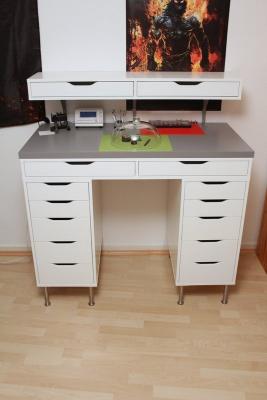Leaderboard
Popular Content
Showing content with the highest reputation on 07/21/14 in Posts
-
Hi Everybody, I just want to clarify that I have absolutely no problem with members, who have their own websites, linking to that website (non commercial). If you could kindly link to the site in your signature rather than in a post then that would be very helpful. If you have a webpage which is highly relevant to a topic already being discussed then, again, you are more than welcome to post a link to that page2 points
-
I've been using the Dumoxel #2 and #5 mainly (I lean towards #5 mostly) but I've seen Mark's tweezers in the videos and they look mighty good and strong....Since my #2's are a little battered I was wondering what were the one's featured in the videos. I'm also open to opinions and suggestions as to what will be a durable and worthy replacements to the above 2. Your input is deeply appreciated! Robert1 point
-
Found this while looking for ideas for my new watchmakers space in our new place... I think it's Awesome! Based on the parts list, it seems it would cost just shy of $500 to build. Looks like a $1500+ unit if you ask me! Here's the link that list the different parts... http://www.ikeahackers.net/2014/03/ikea-watchmakertable.html1 point
-
Hi, I am new to these forums and recently retired from the lubricants industry and now enjoying my new hobby of messing about with watches etc! I see a lot of posts on all forums about lubricants and thought I may be able to help with the basics so giving members a better understanding. This is a very broad subject so I will try and cover in a series of posts relating to specific areas of lubrication. I will try and answer any questions but may defer if I will be covering them in a later post. Firstly 'What are the different types of lubricants?' We have fluids (oils), semi-solids (greases and gels); solids Oils can be mineral (hydrocarbon), vegetable, and animal. Other fluids are generally classed as chemicals or synthasised fluids. Mineral oils are most common nowadays for lubrication but in the past vegetable (olive oil, rapeseed oil etc) and animal (lard, sperm oil, neats foot oil etc) were widely used. Some vegetable and animal oils are still used in mineral oil blends, especially neats foot oil, to provide special properties such as added lubricity. Refined mineral oils are made from crude oil, the refining process removes many of the 'nasties' to give a range of 'base oils' . These base oils have an industry range of viscosities and are used as made or blended together to meet industry standard viscosity bands (ISO VG). To meet specific lubrications needs (hot, cold, high wear, EP, water ingress, cleaning etc etc) chemical and other additives are blended into the basic mineral oil. Sometimes additives are needed to counteract the effect of some of these additives !!). Synthetic Oils can be based on mineral oil or be chemical compounds. Strictly speaking synthetic mineral oils should be called synthesised mineral oil as they are made by re-combining hydrocarbon molecules to make bespoke mineral oils. These are much purer and have better inherent temp, lubricity and oxidation properties, they also need less additives to modify their shortcoming properties. Ordinary mineral oil has molecule chains (her comes the chemistry!!), short, medium and long. The shorter the molecule the more volatile (will evaporate quicker) and lower viscosity (thickness, runniness) it has. The long molecules leave sticky, gummy residues when aged. The additives help to reduce these effects but they will all happen in time, and so the oil 'goes off'. Loss of short molecules can lead to oil viscosity increases and degeneration of the long molecules can lead to oil tickening and gums forming. Synthetic mineral oils can be made to greatly reduce the amount of small and large molecules (called light and heavy ends), so a more stable oil results. Also the natural contaminents of a natural mineral oils (which require additives to control them) are not present. Synthetic Oils based on chemical compounds are also used as specialist lubricants because of their unique properties, but are unlikely to be used in watches etc, but may be used as an additive for very special applications. They can also be very aggressive to some materials especially rubbers, plastics and paints. I'll post about additives etc in another post. Greases can be thought of as a lubricant retained in a sponge. The sponge is what is know as the 'soap' and the lubricant can be any of the above 'oils' that are compatible with the soap. The soap type is again determined by the operating conditions and the degree of specialisation required. Modern trends are to replace soaps with gelling agents but these have a more limited scope of operating conditions. Solid lubricants are materials that generally plate-out onto the working surfaces and can be applied as they are or suspended in a fluid lubricant. Typical solid lubricants are graphite, molybdenum disulphide, PTFE etc. They can cause problems in very tight clearances as they may tend to close them up over time. That's it for now, plenty to ponder on. Hope I haven't bored you too much. I will carry on with more posts if feed back is posiitive.1 point
-
The official ETA take on this is that you do not clean or lubricate the reverser wheels, but replace them. The reason for this is that when they are new they have a factory applied lubricant which keeps thing moving nicely without gumming up. The problem with cleaning them is that they then need re-lubricating, and the issue there is that if the wrong oil is used, or it gets into the wrong places, the pawls stick. However, if my budget doesn't allow for replacement then I am quite happy to put them through the cleaning machine and then very carefully lubricate just the pawls with the smallest amount of 9010 that I can apply, and this works for me. There is a special lubricant that you can use called Lubeta V105. This is a waxy lubricant dissolved in a highly volatile carrier. You simply drop the wheels in and then take them out again. The carrier solvent evaporates and leaves behind a very film of the wax. The DIY version of this is to mix 9010 1:10 with naphtha. I haven't tried either of these techniques but those who have reported their efforts on the inter-web report favourably.1 point
-
Would the metal (aluminum) react with/contaminate the oils in a bad way? I've seen those oil wells are made of some crystalline material or of bakelite...Just a thought.1 point
-
You are welcome Rossco, tips you can mostly exchange. I did with wristband tools of all sorts, including the press type. Sometimes I take a risk, I buy one replacement tip -- after some research -- and try it on the cheap tool I have. Most of the time it works and the tool is considerably upgraded avoiding the need to buy the expensive brand. Sometimes I have to fit the new part and when that happens, most of the time I get a better tool than the expensive brand for much less. It is sort of a gamble and it is also fun.1 point
-
Hi Rossco, I bought originally very cheap screwdrivers from esslinger, but they were wobbly and difficult to use (no quality). I then purchased the Bergeon tips and swapped them. So for about $40sh dollars total I got 8 out of 9 working as they should. The .50 was never good to start with but I don't use it much at this stage. The 2.5 needed a little broadening of the hole but after that it works better than the rest. Just an idea. I got spoiled and started using Bergeon all together but that's just me who am never happy with only one set.... I would strongly recommend that you get those inexpensive round, transparent plastic watchmaker trays with lid. (the ones with divided sections, one of them round). Also the Bergeon oiler set (the applicators not the wells) is not expensive but very effective. For the wells, esslinger has a 3 well stand for about $20.1 point
-
Plastering is an art form, especially ceilings, it's starting to get that finished look now. You will have to double your throughput of watches in order to pay for it all. I am willing to sweep and tidy up + make tea in exchange for lessons.1 point
-
AAA, I started working on rebuilding a watch last month and it would of saved me hours of Googling had I found WillFly's chart. :) A few tips I can pass on which might help you. Some of the American suppliers send movements with batteries. (If you do order from the sates watch out for Royal Mail handling charges on items sent from Canada). If you order from Cousins UK they don't include a battery, you will have to buy it separately from them or someone like www.smallbatterycompany.org.uk (I found them via this site too). It sounds like you are replacing a movement so will have the original hands, if not read up the spec when you find the movement you want, it's a bit of a dark art for newcomers to watch repair like me. When removing or fitting hands it's worth making a dial cover as it VERY easy to spoil a nice face. (I know!). It might also seem obvious but the hands bend very easily. I use a bit of blue tack on the face/dial to hold them in place when gently pushing them back onto their pinions/shafts. My apologies if this is stuff you already know, Bern1 point





